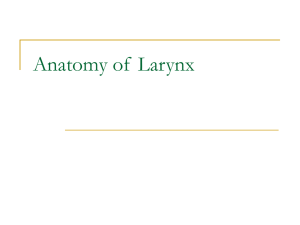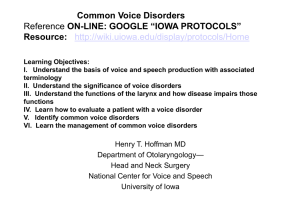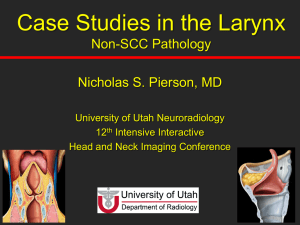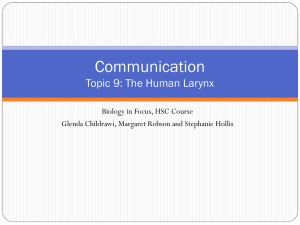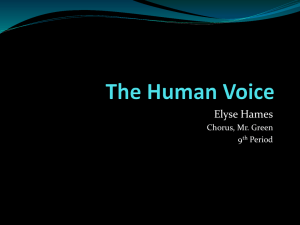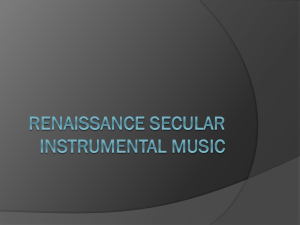Chronic laryngitis
advertisement
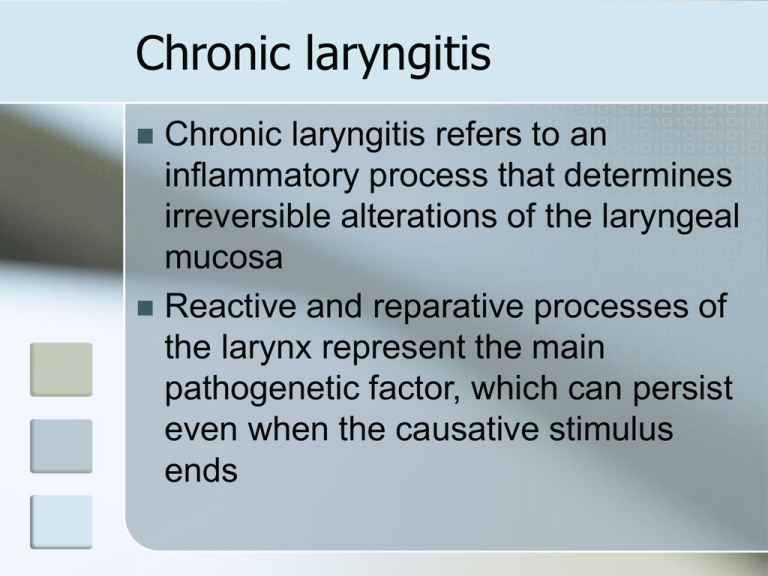
Chronic laryngitis Chronic laryngitis refers to an inflammatory process that determines irreversible alterations of the laryngeal mucosa Reactive and reparative processes of the larynx represent the main pathogenetic factor, which can persist even when the causative stimulus ends 1. 2. 3. 4. Non specific : No specific detectable cause Chronic hyperemic Ch Hypertrophic Atrophic Pachydermia (contact granuloma / contact ulcer ) Specific Chronic granulomatous lesions e.g. Tuberculosis, Syphilis, Scleroma, leprosy, fungal infections & amyloidosis Chronic Hyperemic laryngitis Diffuse inflammatory condition involving the whole larynx particularly true & False vocal cords Causes Recurrent acute laryngitis / Incompletely resolved Ac laryngitis more than 3 weeks Chronic infection in the vicinity sinusitis, tonsillitis, bad orodental hygiene , Ch Bronchitis Occupational factors dust & Fumes Smoking & Alcohol Voice abuse GERD Clinical Features Males affected more than females Hoarseness of voice Fatigue of voice Hawking & irritation larynx Dry irritating cough Laryngoscopy Hyperemia , Vocal cords appear dull & edges are rounded, Viscid secretions on VC / interarytnoid region Treatment Eliminate The cause infection / irritating factors Complete voice rest / Observe proper vocal hygiene Medicated steam inhalation ? Expectorants Chronic hypertrophic laryngitis Advanced stage of hyperemic laryngitis Cellular infiltrate in the submucosa Epithelium may undergo hyperplasia / metaplasia May be generalized involvement False VC (ventricular bands) “Dysphonia plica ventricularis” True vocal cords Rinke’s Edema Causes As for hyperemic chronic laryngitis Laryngoscopy Laryngeal mucosa is thickened & dusky red in colour Vocal cords red & swollen, Edges loose sharp demarcation In Dysphonia plica venticularis false vocal cords swollen, may cover true VCs Treatment Conservative Surgical Stripping of edematous mucosa with micro-scissor Ablation with LASER One side done at a time to prevent Web Atrophic laryngitis Common in women Associated with Atrophic Rhinitis Laryngitis Sicca Exact cause not known Hormonal disturbance, Dietary deficiency, Autoimmune disorder Bacillus ozaenae secondary infection Clinical features Hoarseness Dry irritating cough Dyspnoea due to crusts Laryngoscopy Laryngeal mucosa is dry & atrophic Covered with foul smelling crusts Treatment Primary condition Atrophic rhinitis Steam inhalation 25% glucose in glycerin sprays Expectorants containing Iodides to loosen the crusts Tuberculous laryngitis Secondary to Pulmonary tuberculosis Common in adult males Brochogenic / hematogenous route Bronchogenic route affects posterior larynx --- Interarytnoid region, submucosal tubercles & granuloma Hematogenous Multiple painful ulcers in larynx & pharynx Clinical features Hoarseness Painful ulcers / referred otalgia Odynophagia Laryngoscopy Pale granulations in the interarytnoid region 1. 2. 3. Ulcers of vocal cords mouse eaten appearance Swelling of false VCs & Aryepiglottic folds X-Ray chest Sputum for AFB Biopsy Treatment : As for pulmonary tuberculosis Vocal Nodules Singer‘ nodules Common in voice misusers Teachers, singers, preachers & Vendors Vocal trauma submucosal hemorrhage fibrosis & hyalinization At the junction of anterior 1/3 7 posterior 2/3 ( subject to maximum trauma ) Clinical features H/o misuse of voice Hoarseness Vocal fatigue Laryngoscopy Symmetrical nodular pinkish or grey masses at junction of ant 1/3 & post 2/3 of true vocal cords treatment 1. 2. 3. Conservative Avoid misuse of voice Speech therapy / proper use of voice No shouting / No whisper ? May change the profession Surgical Microlaryngoscopy & LASER

